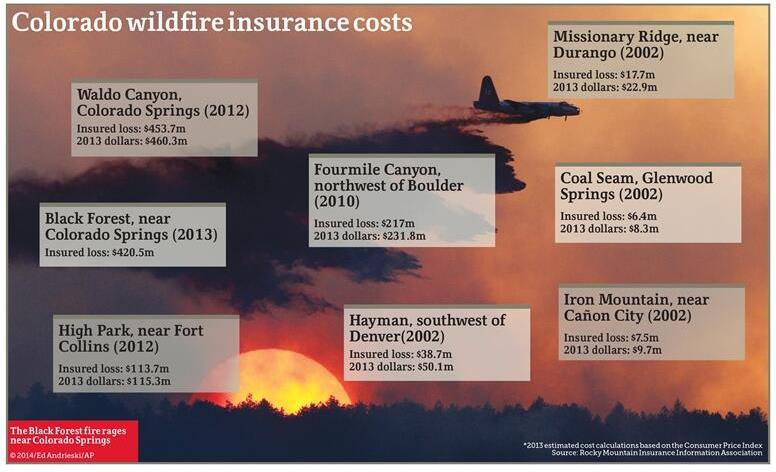When lawmakers and citizens refuse to adequately fund wildfire prevention, mitigation, and suppression programs, sometimes they don’t consider the unintended consequences of their actions. The graphic above, by InsuranceDay.com, illustrates the insured losses in just one state, Colorado, from wildfires since 2002. The numbers do not include the costs of suppressing the fires or the rehabilitation of the burned areas. For example, the $9.8 million spent on stopping the Black Forest Fire is not included.. If the Waldo Canyon, Black Forest, Fourmile Canyon, or High Park fires had been stopped when they were small, the suppression and insurance costs averted would have equaled what it would take to build a professional quality fire management organization — many times over.
Colorado has taken some steps in the last year to improve their response to wildfires, building a small aerial firefighting fleet, and organizing in some areas on the front range to more aggressively implement mutual aid strategies.
And we don’t mean to pick on Colorado — it is just the low-hanging fruit, the state that best illustrates the fallacy of save money now, but increase the costs 10-fold later. The federal government as well as some other states and local governments fall into the same trap.
In 2012 we wrote:
 Dr. Gabbert’s prescription for keeping new fires from becoming megafires:
Dr. Gabbert’s prescription for keeping new fires from becoming megafires:
Rapid initial attack with overwhelming force using both ground and air resources, arriving within the first 10 to 30 minutes when possible.
Some of us remember when this was standard operating procedure, at least in the federal government. CAL FIRE still understands and practices this strategy.


It would be interesting to know how many Colorado voters live in wildland-urban interface… and how many of them are aware of the fact? Colorado Springs wasn’t what most people think of when thinking of forests, but the past two years’ fires liked burning it just fine.
The governor thinks that over 25% of the population lives in the WUI.
http://www.colorado.gov/cs/Satellite/GovHickenlooper/CBON/1251639076858
Unfortunately, cost avoidance isn’t a prime concern of the politicians here in Colorado and no one is ‘keeping score” when it comes to the follow-on costs paid by state and local governments. It doesn’t help that 67% of our forests are federal property and are beyond any local control or processes.
The insurance costs don’t represent a direct expense for the state and although they are impressive, they don’t make much of an impact on the overall political process. The majority of voters in Colorado don’t live in forested areas and since the fires don’t have a direct impact on them, they tend to view the management of Colorado forest fires as someone else’s problem.
Insurance companies are making a difference when it comes to requiring mitigation of insured properties. Some companies no longer underwrite properties in the mountains, and for the rest, the cost of insurance reflects the increased fire risk.
You’re on the mark Bill and hopefully with more awareness of the problem, things will continue to change for the better here in Colorado.
Well Said, Bill.
Excellent Bill. And for R6 where the fire prevention programs, on most of the forests and at the regional level, are woefully low this is very similar to the battle I fought as a fire prevention technician for over two decades – as I watched the programs being whittled away (especially on the Mt. Hood NF and Gifford Pinchot NF).
I would however add one extremely vital component to your “prescription”… That being the “aggressive off-season rx fire and fuels reduction planning and implementing.” This is an aspect too often ignored or forgotten. At least that’s what I’ve been screaming about for 36 years. And I’m not retired yet and not finished screaming.
Well said and described Bill, we are on the same page. We could also look at other low hanging fruit in New Mexico, Arizona & of course California, IE: Rim Fire !!